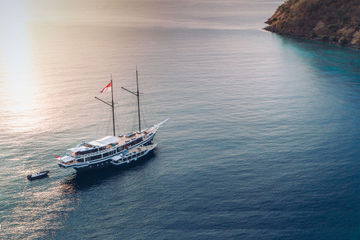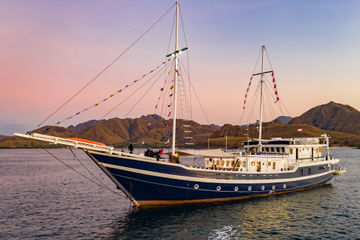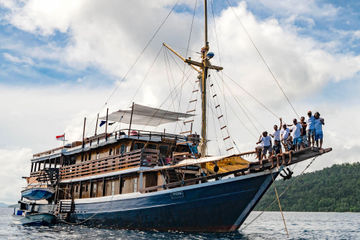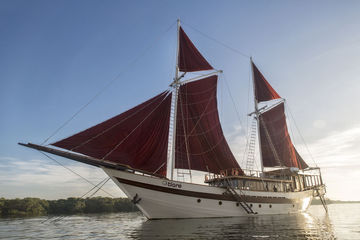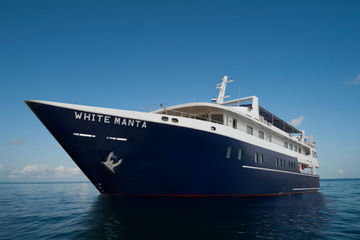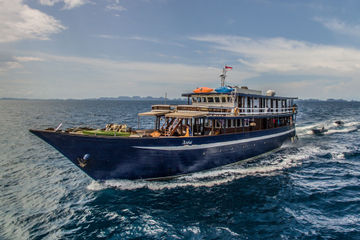Popular Ambon liveaboards Explore all liveaboards
What to Expect On an Ambon Liveaboard
Liveaboards in Ambon are usually offering an itinerary around the Forgotten Islands of the Moluccas. The islands get their name for their general inaccessibility, and so have largely been left alone. Indonesian liveaboards cruising the south of the Moluccas will often use Ambon as their port of arrival or departure. Diving the south of the Moluccas can be achieved all year round thanks to the fantastic climate, but liveaboards tend to only visit during March and April.
Ambon is world famous amongst keen muck divers for it's impressive, wide range of macro life. The island itself holds a fairly significant amount of history, dating all the way back to the spice trade, although locals held a rich culture before this for many years. The United East Indian Company was responsible for building forts in the early 17th century, and every year on 25 April, a ceremony is held to commemorate the Allied soldiers who died in the region during World War II.
Ambon Underwater
Visiting Ambon on a liveaboard cruise will take divers to over 60 sites and consists mostly of muck dives, especially in the harbour. Divers in the Ambon Bay will discover unique and bizarre marine life such as frogfish, mandarinfish, ghost pipefish, harlequin shrimp, flamboyant cuttlefish, octopus, pygmy seahorse, stonefish, scorpionfish, and hundreds of different species of nudibranch.
Boats have discarded all sorts of things over the centuries here, and have created quite the spectacular accumulation of muck that attracts many of the sought-after species. In 2009, a whole new species of frogfish was even discovered, the psychedelic frogfish.
Currents in the harbour are virtually nil, except between a full and new moon where there is usually a small amount of current. Although not strong enough to be of concern from a diving perspective, the current is sufficient to drastically lower the visibility from an impressive 65 feet (20 m) down to 13 feet (4 m). Your liveaboard dive crew will assess the conditions prior to jumping in to maximise your experience. In addition, many of the species will hide under small rocks and generally make themselves scarce, seeking shelter until the current drops again.
Unlike the Lembeh Strait, Ambon has white sands rather than black, presenting a welcome change of experience for an Indonesian muck diver. Many sites are also populated by small coral bommies that attract an unusually high count of reef fish. The reason is that the bommies provide an area of reef in a site that generally has very little reef to speak of. They are like underwater island paradises, absolutely teeming with life and are very often cleaning stations for wrasse and grouper. Virtually all dive sites have several species of nudibranchs, and occasionally you will find blue, yellow and pink rhinopias.
Dive Sites of Ambon
Laha on the Northern coast of Ambon is a very big muck diving site that has been categorised as 3 neighbouring sites, Laha I, II and III. Considered one of the best dive areas in Ambon it's possible to see the same species at all 3 sites, but not usually at one time. Species seem to migrate between the 3 areas, making each dive feel very unique.
The site is also renowned for the overwhelming numbers of eel species including blue ribbon, chain moray, snowflake, and many more. The highly venomous blue-ringed octopus, mimic octopus and wonderpus are all frequent visitors. Fingered dragonets, stargazers and crocodile fish can be spotted camouflaging themselves into the muck, while leaf scorpion fish tend to congregate near the coral bommies.
Silale dive site offers scuba divers colorful elephant ear sponges along with brightly colored leaffish and nudibranchs. Sea cucumbers, cowfish, and lizardfish can also be found here.
Top Tips for Divers
Using nitrox on your liveaboard trip is definitely recommended on the typical muck diving sites around Ambon. Depths are usually very shallow, around 20 to 80 feet (6 to 24 m), and diving on nitrox allows you to safely maximise your time at these sites, especially over the second and third dives of the day.
Good buoyancy control and finning techniques are also conducive to a more enjoyable dive, not just for yourself but for the whole group. The silty bottom of muck dives can be very easily disturbed, and a careless fin kick will blast debris upwards into the water column. The reduced visibility that results is about as close to a 0 visibility situation as possible, owing to the fineness of the silt. A modified frog kick is perhaps the ideal kick to use, gently propelling water upwards and to the rear (and not downwards). This will allow you to slowly move around the site in search for interesting critters while leaving the bed totally untouched and undisturbed.
Getting to Ambon
Liveaboard.com offers great itineraries on the best Ambon liveaboards. Muck diving enthusiasts will enjoy rare fish discoveries, exceptional service and luxury accommodations for the perfect scuba diving holiday.
To reach Ambon, where your liveaboard will depart, first head to Jakarta via Soekarno Hatta International Airport. It is more common to see direct flights from international destinations, although most long-haul flights will connect via Singapore. From Jakarta, it is possible to fly directly to Ambon, and flights to this destination are available on a daily basis. Garuda airline operates many routes in the area, and is rated internationally as the safest airline.
